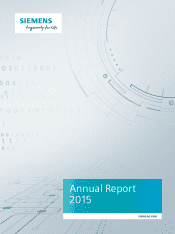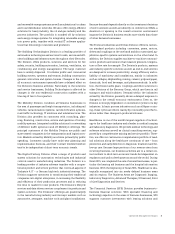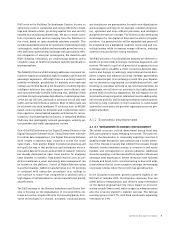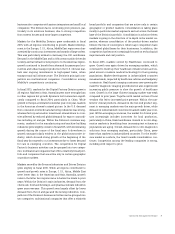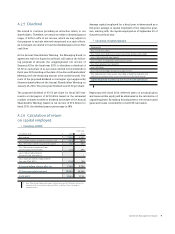Siemens 2015 Annual Report Download - page 6
Download and view the complete annual report
Please find page 6 of the 2015 Siemens annual report below. You can navigate through the pages in the report by either clicking on the pages listed below, or by using the keyword search tool below to find specific information within the annual report.Combined Management Report
equipment, project and structured financing. SFS provides cap-
ital for Siemens customers as well as other companies and also
manages financial risks of Siemens. SFS operates the Corporate
Treasury of the Siemens Group, which includes managing
liquidity, cash and interest risks as well as certain foreign
exchange, credit and commodities risks. Business activities
and tasks of Corporate Treasury are reported in the segment
information within Reconciliation to Consol idated Financial
Statements.
A.1.1.3 RESEARCH AND DEVELOPMENT
Our research and development (R & D) activities are ultimately
geared to developing innovative, sustainable solutions for our
customers – and the Siemens businesses – and simultaneously
safeguarding our competitiveness. For these reasons, we focus
in particular
> on enabling energy supplies that are also economically sus-
tainable;
> further enhancing efficiency in the generation of renewable
and conventional power and minimizing losses during power
transmission;
> finding novel solutions for smart grids and for the storage of
energy from renewable sources with irregular availability;
>
promoting the efficient utilization of energy, especially in
buildings, industry and transportation, e. g. through highly
efficient drives for production facilities or for local and
long-distance trains;
>
creating the highly flexible, connected factories of tomorrow
using advanced automation and digitalization technologies;
>
turn unstructured data into value-adding information, e. g.
when providing services such as preventive maintenance;
> advancing the integration of medical imaging technology, in
vitro diagnostics and IT for medical engineering to support
achievement of improved patient outcomes.
Beyond these points of focus, we recognize how important
highly sophisticated software solutions are for all the fields of
business in which Siemens is active. R & D activities are carried
out by our businesses as well as our Corporate Technology (CT)
department.
Corporate Technology is both a creative driver of disruptive
innovations and a partner to the Siemens businesses. The R & D
activities are focused on the company’s core activities in the
fields of electrification, automation, and digitization. In many
research projects, CT works closely with scholars from leading
universities and research institutions. These partnerships, along
with a close collaboration with start-ups, are an important part
of Siemens’ open innovation concept, which is designed to
make the company even more innovative.
In fiscal , we reported research and development expenses
of € . billion, compared to € . billion in fiscal . The re-
sulting R & D intensity, defined as the ratio of R & D expenses
and revenue, was . %, thus above the R & D intensity of . %
in fiscal . As of September , , Siemens held approx-
imately , granted patents worldwide in its continuing
operations. As of September , , it held approximately
, granted patents. On average, we had , R & D
employees in fiscal .
Research and Development in our businesses
R & D at the Power and Gas Division concentrates on develop-
ing products and solutions for enhancing efficiency, flexibility
and economy in power generation and in the oil and gas indus-
try. These products and solutions include turbomachinery –
primarily high-performance, low-emission gas turbines for
single operation or for combined cycle power plants – and com-
pressor solutions for various process industries. The Division’s
technology initiative started in fiscal is aimed at intensify-
ing R & D in innovative materials, advanced manufacturing
methods and plant optimization. Along with promoting digita-
lization in overall product lifecycles, Power and Gas is on track
preparing for changing energy markets and their increasingly
diversified centralized and decentralized structures.
At Siemens’ Wind Power and Renewables Division, our R & D
efforts are focused on innovative products and solutions that
allow us to take the lead in performance, improve our compet-
itiveness, and build a stronger business case to present to our
customers. This includes finding ways to more intelligently
monitor and analyze turbine conditions, and smart diagnostic
services. Our R & D efforts also focus on digitalization. At our
remote diagnostics center in Brande, Denmark, we collect digi-
tal data from nearly , turbines in more than countries:
a total of more than million data sets annually. We use this
data to provide value for our customers: in % of cases, prob-
lems can be corrected and turbines restarted without the need
to send out a service team.
The R & D activities of our Energy Management Division focus
on preparing our portfolio for changes on all voltage levels in
the world of electricity. The increasing infeed of renewable
energy to power grids requires that those grids become more
flexible and efficient, particularly with distributed generation
on the rise. The digitalization of future grids will enable intel-
ligent grid operation and data-driven services. Cost-out pro-
grams and optimization of our footprint are improving the
competitiveness of our product portfolio on global markets.
Our innovations are centered on power electronics, digitaliza-
tion or grid stabilization. The full integration of energy supply
systems with process automation is a core portfolio element for
industrial applications and infrastructures.

